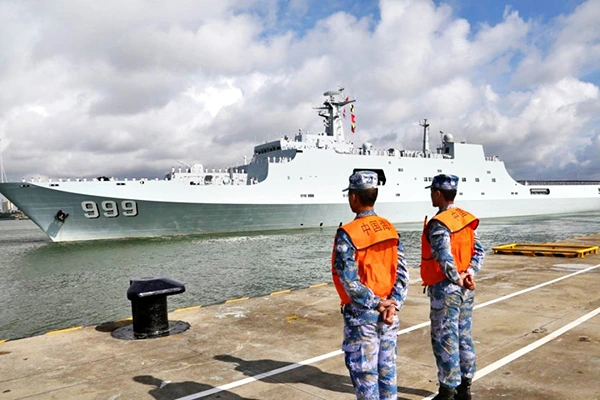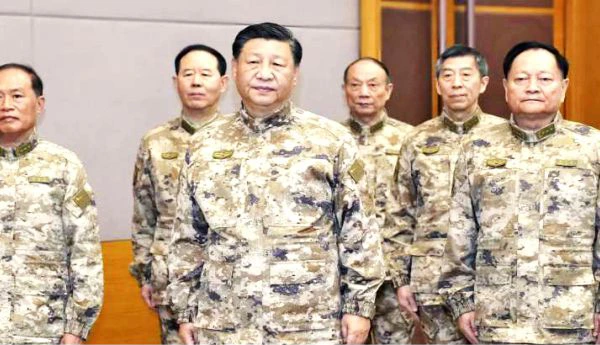The PLA seeks to modernize its capabilities and improve its proficiencies across all warfare domains so that, as a joint force, it can conduct the full range of land, air, and maritime, as well as nuclear, space, counterspace, electronic warfare (EW), and cyberspace operations.
The PLA’s evolving capabilities and concepts continue to strengthen the PRC’s ability to “fight and win wars” against a “strong enemy” (a euphemism likely for the United States), counter an intervention by a third party in a conflict along the PRC’s periphery, and project power globally.
In 2021, the PLA continued to make progress implementing major structural reforms, fielding modern indigenous systems, building readiness, and strengthening its competency to conduct joint operations.
People’s Liberation Army Army (PLAA). The PLAA has approximately 975,000 active-duty personnel in combat units and is the primary ground fighting force in the PLA. In 2021, the PLAA emphasized realistic training scenarios and standardization of training methods during the exercise STRIDE-2021 and throughout extensive joint amphibious training that utilized both People’s Liberation Army Navy (PLAN) and civilian roll-on-roll-off (RORO) vessels. PLAA and Russian Army units participated in ZAPAD/INTERACTION-2021, a large-scale joint exercise to expand cooperation between the two militaries, which was conducted on PRC soil for the first time.
People’s Liberation Army Navy (PLAN). The PLAN is numerically the largest navy in the world with an overall battle force of approximately 340 ships and submarines, including approximately 125 major surface combatants. As of 2021, the PLAN is largely composed of modern multi-mission ships and submarines. In 2021, the PLAN’s overall battle force shrank due to the transfer of 22 early flight JIANGDAO class corvettes to the China Coast Guard (CCG). The PLAN commissioned its fourth RENHAI class cruiser in late 2021 and resumed series construction of the JIANGKAI II class frigate. The PLAN commissioned two YUSHEN class amphibious assault ships, one each in April 2021 and April 2022. The PLAN launched a third hull in the YUSHEN class in January 2021, which is currently undergoing sea trials prior to commissioning.
People’s Liberation Army Air Force (PLAAF) and PLAN Aviation. The PLAAF and PLAN Aviation together constitute the largest aviation force in the region and the third largest in the world, with over 2,800 total aircraft (not including trainer variants or uncrewed aerial systems (UAS)) of which approximately 2,250 are combat aircraft (including fighters, strategic bombers, tactical bombers, multi-mission tactical, and attack aircraft). The PLAAF is rapidly catching up to Western air forces and continues to modernize with the delivery of domestically built aircraft and a wide range of UAVs. In October 2019, the PLAAF publicly revealed the H-6N as its first nuclear- capable air-to-air refuelable bomber, signaling the airborne leg of its nuclear triad.
People’s Liberation Army Rocket Force (PLARF). The PLARF organizes, mans, trains, and equips the PRC’s strategic land-based nuclear and conventional missile forces, associated support forces, and missile bases. The PLARF is advancing its long- term modernization plans to enhance its strategic deterrence capabilities. In 2021, the PLARF launched approximately 135 ballistic missiles for testing and training. This was more than the rest of the world combined, excluding ballistic missile employment in conflict zones. In 2021, the PRC continued building three solid-fueled intercontinental ballistic missile (ICBM) silo fields, which will cumulatively contain at least 300 new ICBM silos.
Strategic Support Force (SSF). The SSF is a theater command-level organization established to centralize the PLA’s strategic space, cyberspace, electronic, information, communications, and psychological warfare missions and capabilities. The SSF’s Network Systems Department is responsible for information warfare with an integrated mission set that includes cyberspace warfare, technical reconnaissance, electronic warfare, and psychological warfare.
• The PLA views space superiority, the ability to control the space-enabled information sphere and to deny adversaries their own space-based information gathering and communication capabilities, as critical components in conducting modern “informatized warfare.”
• The PLA continues to invest in improving its capabilities in space-based intelligence, surveillance, and reconnaissance (ISR), satellite communication, satellite navigation, and meteorology, as well as human spaceflight and robotic space exploration.
Joint Logistic Support Force (JLSF). The JLSF provides integrated joint logistics support for the PLA. The JLSF is concentrating its efforts on improving joint strategic and campaign-level logistic efficiencies through training and on integrating civilian products and services. The JLSF also had an active role in coordinating with civilian entities to provide logistic support in response to the ongoing COVID-19 pandemic.
Joint Capabilities in Development
The PLA is aggressively developing capabilities to provide options for the PRC to dissuade, deter, or, if ordered, defeat third-party intervention in the Indo-Pacific region.
The PLA is also developing the capabilities to conduct military operations deeper into the Indo-Pacific region, and in some cases, globally.
Although the PLA has undertaken important structural reforms to promote joint operations, its capability to carry out joint operations in support of counter- intervention or joint campaigns outside the First Island Chain remains in its infancy.
Capabilities for Counter-intervention and Power Projection
The PRC’s counter-intervention strategy aims to restrict the United States from having a presence in China’s immediate periphery and limit U.S. access in the broader Indo- Pacific region. The PLA’s anti-access/area-denial (A2/AD) capabilities are, to date, the most robust within the First Island Chain, although the PLA is increasingly able to project power into the Philippine Sea and the PRC seeks to strengthen its capabilities to reach farther into the Pacific Ocean.

• Long-Range Precision Strike and Supporting ISR. PLA doctrinal writings state that precision attack in all warfare domains is critical in modern war. PLA writings state that precision weapons are not only force multipliers, but also a means of “war control” to prevent escalation.
• Integrated Air Defense System (IADS). The PRC has a robust and redundant IADS architecture over land areas and within 300 nautical miles (mm) (556 kilometers (km)) of its coast that relies on an extensive early warning radar network, fighter aircraft, and a variety of Surface-to-Air Missile (SAM) systems. The PRC has also placed radars and air defense weapons on outposts in the South China Sea, further extending the range of its IADS. It also employs point defenses, primarily to defend strategic targets against adversary long-range cruise missiles and airborne strike platforms.
• Hypersonic Weapons. China’s deployment of the DF-17 hypersonic glide vehicle (HGV)-armed Medium-Range Ballistic Missile (MRBM) will continue to transform the PLA’s missile force. The system, fielded in 2020, is possibly intended to replace some older Short-Range Ballistic Missile (SRBM) units, according to PRC media, and is designed to strike foreign military bases and fleets in the Western Pacific, according to a PRC-based military expert.
Advancing Toward an Informatized Military
The PLA considers information operations (IO) as a means of achieving information dominance early in a conflict and continues to expand the scope and frequency of IO in military exercises.
The PRC presents a significant, persistent threat of cyber-enabled espionage and attack on an adversary’s military and critical infrastructure systems.
The PLA is pursuing next-generation combat capabilities based on its vision of future conflict, which it calls “intelligentized warfare,” defined by the expanded use of artificial intelligence (AI) and other advanced technologies at every level of warfare.
Space and Counterspace Capabilities
The PLA continues to acquire and develop a range of counterspace capabilities and related technologies, including kinetic-kill missiles, ground-based lasers, and orbiting space robots, as well as expanding space surveillance capabilities, which can monitor objects in space within their field of view and enable counterspace actions.
The PLA views space operations as a means to deter and counter third-party intervention during a regional military conflict. Moreover, PRC defense academics suggest that reconnaissance, communication, navigation, and early warning satellites could be among the target of attacks designed to “blind and deafen the enemy.”
Nuclear Capabilities
Over the next decade, the PRC aims to modernize, diversify, and expand its nuclear forces. Compared to the PLA’s nuclear modernization efforts a decade ago, current efforts exceed previous modernization attempts in both scale and complexity.
The PRC is investing in and expanding the number of its land-, sea-, and air-based nuclear delivery platforms and constructing the infrastructure necessary to support this major expansion of its nuclear forces. The PRC is also supporting this expansion by increasing its capacity to produce and separate plutonium by constructing fast breeder reactors and reprocessing facilities.
In 2021, Beijing probably accelerated its nuclear expansion. The Department of Defense estimates that the PRC’s operational nuclear warheads stockpile has surpassed 400.
The PLA plans to “basically complete modernization” of its national defense and armed forces by 2035. If China continues the pace of its nuclear expansion, it will likely field a stockpile of about 1500 warheads by its 2035 timeline.
Chemical and Biological Research
The PRC’s chemical and biotechnology infrastructures are sufficient to research, develop, and produce some chemical and biological agents or toxins on a large scale.
China probably has the technical expertise to weaponize chemical and biological warfare (CBW) agents, and its robust armaments industry and numerous conventional weapon systems, including missiles, rockets, and artillery, probably could be adapted to deliver CBW agents.
The PRC continues to engage in biological activities with dual-use applications, which raise concerns regarding its compliance with the Biological Weapons Convention. Such PRC biological activities include studies at PRC military medical institutions on potent toxins with dual-use applications.
The United States cannot certify that the PRC has met its obligations under the Chemical Weapons Convention due to concerns regarding the PRC’s research on pharmaceutical-based agents and toxins with potential dual-use applications.
Based on the Annual Report to U.S. Congress by the Secretary of Defense: Military and Security Developments Involving the People’s Republic of China, 2022
PLA to leverage advanced technology, AI
Chinese President Xi Jinping presented a report on behalf of the 19th CCP Central Committee at the 20th National Congress of the Communist Party of China (CCP) on October 16, 2022. An important point in the report was regarding the use of artificial intelligence (AI) for the People’s Liberation Army (PLA).
The PLA is aiming to leverage advanced technology for its use of unmanned weapons and artificial intelligence. China aims to achieve military modernisation of the PLA to a stage where it is fully automated and computerised by 2027.
According to Xi Jinping, expeditiously upgrading the PLA to a “world-class” force is the need of the hour, as per the news report. He spoke about his resolve to speed up the integrated development of the PLA using “mechanization, informatization, and the application of smart technologies.”
China will focus on C4ISR for PLA i.e. command, control, communications, computers, intelligence, surveillance, and reconnaissance. The aim of China’s PLA is to be prepared for symmetric, asymmetric and cyberspace warfare.
China has put a large number of robotic and unmanned systems, and advanced missiles with precision guidance in all services of the PLA. PLA is working on unmanned vehicles for logistical purposes while PLA Navy is focusing on unmanned surface vessels and submarines. Furthermore, PLA Airforce is working on unmanned systems.
The PLA Rocket Force wants to create full-pledged remote sensing, target identification, and decision support. PLA Strategic Force is working on enhancing the AI capabilities for its electronic, cyber, space and psychological warfare.
China’s strategic considerations towards the advancement of technology include the reunification of Taiwan as it has been quite persuasive with this goal under Xi. Civil-military fusion of technology is another reason for China’s technological pursuit.
China is aware that fusion between the private and public sectors is going to be influential with regard to technological leadership in the world. China has been encouraging private-sector companies in the development of artificial intelligence and other critical technologies. The Chinese government is also offering subsidies to the companies.


















